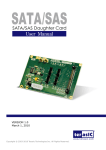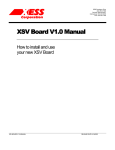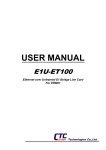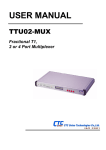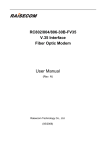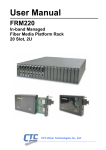Download Chapter 3. Data Module
Transcript
USER MANUAL G703/64-RM G.703 64Kbps Co-Directional Rack Mount 1 to 13 Ports or 12 Ports + SNMP Table of Contents Chapter 1. Introduction …………………………………………... 1 1.1 General …………………………………………………….. 1 1.2 Functional Description ……………………………………. 1 1.3 Technical Specifications …………………………………... 3 1.4 E1 Signal Structure ……………………………………….. 4 1.5 Applications / Capabilities …………………………………6 Chapter 2. Installation ……………………………………………. 9 2.1 General …………………………………………………….. 9 2.2 Site Preparation …………………………………………… 9 2.3 Mechanical Assembly ……………………………………... 9 2.4 Electrical Installation ……………………………………… 10 2.5 Power Supply Modules …………………………………… 12 Chapter 3. Data Modules ………………………………………… 13 3.1 Data Modules Overview …………………………………... 13 3.2 Data Module LED Indicators …………………………….. 16 3.3 V.35 Data Module …………………………………………. 17 3.4 RS-530 Data Module ……………………………………… 18 3.5 RS-449 Data Module ……………………………………… 19 3.6 X.21 Data Module …………………………………………. 20 3.7 ET10 Ethernet Module ……………………………………. 21 i Table of Contents Chapter 4. Loop Back Testing …………………………………... 23 4.1 General ……………………………………………………... 23 4.2 User Activate Loop Back …………………………………. 23 4.3 E1 Link local digital loop back ……..…………….………. 23 4.4 Data Port local analog loop back ……………….………… 24 4.5 E1 Link remote loop back ………………………………… 24 4.6 BERT local loop back ……………...……………………… 25 4.7 BERT remote loop back for system test .………………… 25 Chapter 5. Troubleshooting ……………………………………… 27 5.1 General …………………………………………………….. 27 5.2 Connections .……………………………………………….. 27 5.3 Configuration ..…………………………………………….. 28 5.4 G703/64 Card testing .………………………………………….. 29 Appendix A. DIP Switch Setting Tables ………………………. 33 Notes: …………………………………………………………………. 39 Technical Inquiry Card ii Chapter 1. Introduction 1.1 General The G703/64-RM is a 4U (7") high 19" Rack, containing multiple G.703 64Kbps Codirectional to Datacom converters for network access. The G703/64-RM provides an economic solution in high density installations such as central offices. There are 13 slots available for installation of G703/64 Cards (G.703 64Kbps Co-directional) into the G703/64-RM compact RACK. An optional SNMP Card may be installed into the last slot, for local and remote management purposes, leaving 12 slots available for G703/64 Cards. Each G703/64 Card may be linked to a remote G703/64A or G703/64A-STD stand alone 64Kbps Co-directional Access Unit to provide a variety of LAN-to-LAN, Video Conference, Host to client, or Host to Host applications over G.703 64Kbps Network Services. 1.2 Functional Description The G703/64-RM may optionally incorporate two separate Power Module supplies, which, depending on the model, may derive power from either an AC power source (95~250VAC) or DC (-54 to -42VDC) power source. The power supply modules provide for power sharing and are hot swappable even during the G703/64 Cards' transmissions. The G703/64-RM provides all interface connections on the rear panel. RJ-45 and Terminal Blocks are used for G.703 64Kbps Co-directional interface connections, while optional cable adapters are used to convert the HDB26 DCE ports to V.35, RS-232, RS-530, RS-449 or X.21. When cards are inserted in slots, LEDs on the front panel will show both the Codirectional Line and Data port statuses, Power Status, and any Alarm indications. The G703/64 Card data channel supports a fixed transmission rate of 64Kbps on two twisted pair wire (4-wires) for an approximate operating range of up to 800 meters. (over 24AWG wire). The G703/64-RM and G703/64 Cards fully meet ITU-T specifications including ITU-T G.703 and G.823. Each G703/64 Card features V.54 diagnostic capabilities for performing local loop back and remote loop back. The operator at either end of the G.703 line may test both the G703/64 Card and the line in the digital loop back mode. The loop back is controlled by either a manual push-button switch or by the DTE interface for V.35 or RS-530. 1 G703/64-RM APR 2003 Chapter 1. Introduction When the local loop back switch is activated, an internal 511 bit pseudo random test pattern is generated, according to ITU-T, for direct end-to-end integrity testing. The Err indicator LED flashes for each bit error detected. Multiple clock source selection provides maximum flexibility in connecting both the G.703 and user data interface. The G.703 64Kbps converter may be clocked from the recovered receive clock, from user data port, from both the recovered receive clock and user data port (transparent clock) or from the on-card (internal) oscillator. When the G703/64-RM is ordered with an optional SNMP Card, the card is placed in slot number 13. Each G703/64 Card will have DIP Sw1-8 turned ON to enable SNMP setting. In this mode, the other DIP switch settings are ignored while the SNMP Card controls all settings. Control is accomplished either via local control on the asynchronous RS-232 craft port with an VT-100 terminal (terminal mode) or via Ethernet and any standard SNMP network management software. If the SNMP Card option is not installed, slot number 13 may hold an additional G703/64 Card. However, only DIP switch configuration may be applied to all cards in the rack. Figure 1-1 : G703/64-RM Block Diagram 2 G703/64-RM APR 2003 Chapter 1. Introduction 1.3 Technical Specifications G.703 64Kbps Link Framing Bit Rate Line Code Impedance Transmit Levels Pulse amplitude Zero amplitude Unframed 64kbps Co-directional 120 Ohm 1.00V +/-10% (120 Ohm) User Data Channel Interface V.35 Type RS-530 RS-449 X.21 RS-232 I/F HDB26 female Connectors Line Code NRZ 0.0V +/-0.1V Data Rate Transmit Frequency Tracking +/-100ppm Clock Modes Jitter performance According to ITU-T G.823 Recovery (Network) Pulse shape complies with I/F connectors ITU-T G.703 Shielded RJ-45 or 5 pin Molex TM Master (internal) Transparent (Bidirectional) Data Port (external) Handshaking control signals 64Kbps(Sync) 19.2Kbps (Async) Rx and Tx clock recovered from G.703 Timing Rx and Tx clock internal oscillator Sync to Rx clock (transparent) Tx and Rx both from ETC CTS constantly ON DSR constantly ON except during test Table 1-1 : G703/64-RM Specifications 3 G703/64-RM APR 2003 Chapter 1. Introduction 1.4 G.703 64K Signal Structure The G.703 Interface used in the G703/64A-STD has a through rate of 64Kbps and operates in codirectional mode as described in more detail below. Codirectional The term codirectional is used to describe an interface across which the information and its associated timing signal are transmitted in the same direction (see Figure 1-2). Equipment Equipment Data signal Timing signal Figure 1-2; Codirectional interface This mode is the most popular for point-to-point applications. In this case, any remote G703/64A or G703/64A-STD units should have their Dip switches set to the codirectional mode. All timing modes (recovery, transparent, dataport or oscillator) are possible in codirectional mode. 4 G703/64-RM APR 2003 Chapter 1. Introduction G.703 Codirectional Code Conversion Rules Bit number 7 8 1 2 3 4 5 6 7 8 1 64 kbit/s data 1 0 0 1 0 0 1 1 1 0 1 Steps 1 - 3 Step 4 Step 5 Violation Violation Octet timing Figure 1-3; G.703 Codirectional Code Conversion Rules Illustration Step 1: A 64Kbps period is divided into four unit intervals. Step 2: A binary "one" is coded as a block of four bits "1100". Step 3: A binary "zero" is coded as a block of four bits "1010". Step 4: The binary signal is converted into a three-level signal. Step 5: A "Violation" block marks the last bit in an octet. 5 G703/64-RM APR 2003 Chapter 1. Introduction V 1 ,0 3 ,1 2 µs (3 ,9 – 0 ,7 8 ) 0,5 3 ,5 1 s (3,9 – 0,39) 3,9 µ s 0 4,29 µs (3 ,9 + 0, 39 ) 6 ,5 µ s (3,9 + 2,6) 7 ,8 µ s (3 , 9 + 3 , 9 ) a)Mask for single pulse V 1 ,0 7 ,0 2 µs 0 ,5 (7 ,8 – 0 ,7 8 ) 7,41 µs (7 ,8 – 0 ,3 9 ) 7,8 s 0 8 ,1 9 µ s (7,8 + 0,39) 1 0 ,4 µ s (7 ,8 + 2, 6 ) 1 1 ,7 s (7 , 8 + 3 , 9 ) b)Mask for double pulse Figure 1-4; Pulse Masks for the 64Kbps codirectional interface. 6 G703/64-RM APR 2003 Chapter 1. Introduction Data Port Interface The Data Port interface of the G703/64K Card is configurable for four different electrical interfaces. Configuration settings performed on the internal Dip switches select the electrical standard while adapter cables provide the standard physical connections to V.35, X.21, RS-232 or RS-449 (V.36). When an SNMP card is installed in the system rack, the interface may be selected through the software. The actual HDB26F pin connector definitions and adapter cable pin outs may be found in Appendix B of this manual. Remote Loop back V.54 remote loop back may be implemented, depending upon the setting of DSW2-7. When set to "ON", the unit will be able to send or receive standard V.54 loop back codes. When set to "OFF", the front panel "Rem loopbk" switch will have no function and the unit will ignore any in-band loop back codes. DSW2-6 will enable or disable the "auto release" loop back function. When DSW2-7 is enabled and when "auto release" is enabled (DSW2-6 "ON"), if the unit enters loop back due to reception of the loop back code from the remote unit (the remote unit has its "Rem loopbk" push-button depressed), normal operation will automatically resume (loop back will release) after a 15 minute period of time. OPERATION: Front Panel Switch Functions Local digital: This pushbutton switch initiates a loop back to the connected DTE device connected to the unit's data port. Local analog: This pushbutton switch initiates an analog loop back to the connected G.703 device. Remote digital: This pushbutton switch sends a loop back code to the remote unit which enables its local analog loop back. Test: This pushbutton switch initiates the internal 511 pattern generator. If the Remote digital pushbutton is pressed or if the remote unit has its Local analog switch depressed, the local unit will receive and test the 511 pattern for errors. The Error LED will flash for each bit error received. Figure 10; Front Panel Graphic LED Indicators PWR TD RD RTS DCD TX RX Signal Loss Timing Loss Error TEST Unit is powered ON. Transmit data from the connected DTE. Receive data at output of unit receiver. ON when unit data transmission is desired Constantly ON G.703 Transmit data. G.703 Receive data. G.703 Signal loss. G.703 Timing loss. A G.703 error has occurred. Test pattern generator is active and/or a loop back is active. 7 G703/64-RM APR 2003 Chapter 1. Introduction 1.5 Applications / Capabilities In the following example, the G703/64-RM is installed at an ISP's central office and provides "last mile" access to corporate customers over dedicated G.703 64Kbps transmission lines. The customer site utilizes a single data port converter, which could be one of our pack series or standalone units. The G703/64 Cards in the G703/64-RM could all be set to internal oscillator timing or they could receive timing from the DTE on the data port. The remote units would all be set to recovery. Figure 1-2 : G.703 64Kbps nest for ISP In the next application example, the G703/64-RM is used in a point-to-point E1 line environment. Each G703/64 Card acts as a stand alone Digital Access Unit, connecting individual twisted pair lines to data port interfaces. For any G.703 64K link, one converter should provide internal timing while the linked unit should be set to recovery. Figure 1-3 : Point-to-point Application of G703/64-RM 8 G703/64-RM APR 2003 Chapter 1. Introduction In the last application example, the G703/64-RM 's G703/64 Cards provide multiple data port connections via G.703 64K lines connected through an E1 multiplexer from an E1 line. Since the timing is normally passed from the network side, the G703/64 Cards should all be set to recovery. Figure 1-5 : Multiple G.703 64K Access via E1 multiplexer 9 G703/64-RM APR 2003 Chapter 1. Introduction This page left blank intentionally. 10 G703/64-RM APR 2003 Chapter 2. Installation 2.1 General This chapter explains in detail the requirements and procedures for the installation of the G703/64-RM Rack Mount Series G.703 64K Interface Converter Unit. 2.2 Site Preparation Install the G703/64-RM within reach of an easily accessible grounded AC outlet. The outlet should be capable of furnishing 90 to 250 VAC. Allow at least 10cm (4 inch) clearance at the rear of the G703/64-RM for signal lines and interface cables. 2.3 Mechanical Assembly The G703/64-RM is designed for rack mount installation and only requires 4U space (7") in a standard EIA 19 inch rack. It is highly recommended that the unit be placed in a rack. The G703/64-RM is delivered completely assembled. No provision is made for bolting the G703/64-RM to a tabletop. Figure 2-1 : Rackmount Installation of the G703/64-RM Unit 11 G703/64-RM APR 2003 Chapter 2. Installation 2.4 Electrical Installation 2-4-1. Power connection In the AC model, AC power is supplied to the G703/64-RM through a standard IEC 3-prong receptacle, located on the rear of the chassis. In the DC model, DC –48V is connected to the lower terminal block, observing the proper polarity. The G703/64-RM should always be grounded through the protective earth lead of the power cable in AC installations, or via the ground connection for DC installations. The line fuses for the G703/64-RM are located on the Power Module units themselves. Access to the fuses requires removal of the Power Module card. The fuse, a 20mm type, is located in the fuse holder labeled "F1". Make sure that only fuses of the same rating are used for replacement. Do not use repaired fuses or short-circuit the fuse holder. Mains Switch in back Power Module (one or two) G703/64-RM Chassis Line Fuse Holder Location Figure 2-2 : Fuse Location on AC Power Module 12 G703/64-RM APR 2003 Chapter 2. Installation 2-4-2. Rear panel connectors The G703/64 Cards install into the front of the G703/64-RM and receive DC power from the back plane or "main board". The back plane provides both DC power to the G703/64 Cards and routes signals from the cards to the G.703 64K (CSU) and data port (DSU) connectors accessible at the rear of the G703/64-RM. Three interface connector groups are provided for each slot. The G.703 64K signals may use either the RJ-45 or the 5pin Molex connectors with terminal block adapters for balanced transmissions. The data port connections are made with optional adapter cables, using a common panel connector, HDB26F for all interfaces. Alarm Relay Contacts Mains Switch Molex to terminal post adapter IEC AC Mains Input G.703 64K Molex G.703 64K RJ-45 TP HDB26F Data Port HDB26M adapter cables for data port Figure 2-3 : G703/64-RM Rear Panel Connections 13 G703/64-RM APR 2003 Chapter 2. Installation 2.5 Power Supply Modules The Power Supply Modules in the G703/64-RM are available in two versions, AC or DC. The AC version supports input voltages of 90 to 250 volts at frequencies of 50 to 60 Hertz. The DC version supports –42 to -54VDC input voltage. Only one power supply module is required to power a completely full rack. When two Power Supply Modules are installed, the supplies are hot swappable, meaning any one supply may be removed and replaced without impacting the operation of the G703/64-RM Rack. The power supply modules of the are load sharing. When an AC Power Module is used in the G703/64-RM, AC power enters from the IEC mains input connector on the rear panel. AC power is supplied to the AC Power Module card(s) when the mains toggle switch is closed. The AC passes through the F1 fuse(s), located on the Power Module card(s). The AC power is rectified and filtered before being passed to the regulator module. The regulator module is factory adjusted to provide 48VDC to the back plane with complete regulation and over-voltage, over-current, and over-temperature protection. When a DC Power Module is used in the G703/64-RM, DC –48V enters from the terminal block on the rear panel (see Figure 2-4). DC power is supplied to the DC Power Module card(s) when the mains toggle switch is closed. The DC passes through the F1 fuse(s), located on the Power Module card(s). The DC power passes through the rectifier and filtering circuits, which provide reverse polarity protection before being passed to the DC-DC regulator module. The regulator module is factory adjusted to provide 48VDC to the back plane with complete regulation and over-voltage, over-current, and overtemperature protection. Mains Switch 3-pole terminal block for –48VDC Input plus Frame Ground Figure 2-4 : DC Model Power Connection 14 G703/64-RM APR 2003 Chapter 3. Data Module 3.1 Data Module Overview The Data Modules for the G703/64-RM are G.703/64K Cards which slide into the G703/64-RM chassis, and interface with the pack panel "main board". The back panel provides an interface connection to the G703/64 Cards for power, channel connection, data port connection and control logic (for optional SNMP/local management terminal). The cards are designed to be "hot" swappable, meaning the G703/64-RM chassis need not be powered off in order to replace a card or pull it for configuration setting. Each G703/64 Card has a protection fuse and its own on card DC-DC regulator. Each G703/64 Card in the G703/64-RM receives the DC buss 48VDC and uses its own on-card DC to DC converter to derive the required operating voltage of 5VDC. Removal and installation of G703/64 Cards with the rack chassis under power will not effect the operation of other G703/64 Cards. The one exception to this would be a case where the improper fuse (rated too high) were placed on a defective G703/64 Card, causing the main AC or DC power module's fuse(s) to open. It should also be noted, that the G703/64 Cards themselves have no redundancy. Therefore, if a card is pulled from the chassis while the communication link is active, that link will be broken. Removal of a G703/64 Card is accomplished by loosing the two (2) captive screws on the face plate of the card module, and then pulling the card straight out of the chassis with the same screws. Apply equal pulling force to both top and bottom captive screws to avoid the card binding in the rails of the chassis. (refer to Figure 3-1) Replace the card by reversing the procedure, align in the slot groove and gently seat the card. Retighten the captive screws. G703/64 Card Configuration DIP Switches Card Rails Interface Connector Captive Screws G703/64-RM Chassis Figure 3-1 : Removal/Replacement of G703/64 Card in G703/64-RM Chassis 15 G703/64-RM APR 2003 Chapter 3. Data Module The G703/64 Card in the G703/64-RM uses a common PC board for all data port interfaces. Only the DIP switch settings and appropriate interface adapter cable is necessary for proper functioning. Care must always be taken when swapping boards. Always check and match the correct interface setting with the proper interface adapter cable. There are two (2) DIP (Dual Inline Package) Switches located along the top of the G703/64 Card numbered DSW1~2. The switches function to set the Rx and Tx timing mode, data interface type, Rx and Tx clock polarity, handshaking mode, and loop back functioning. Please refer to Appendix A for the DIP setting table. Located on the upper half of the front panel are the indicator LEDs. There is a green power indicator which will light when the card is placed in an active chassis. Failure of this LED to light indicates a possible power failure on the G703/64 Card itself. The TD, RD, RTS, and DCD yellow LEDs indicate status of the data communication port. The red Signal Loss, Timing Loss and Error LEDs all indicate error conditions on the G.703 64K line or link connection. When loop back testing is being performed, the red Test LED will light. If any bits are received in error, the red Error LED will blink. Located on the lower half of the front panel are the manual test switches. The top three switches set the type of loop back test to be performed. The bottom switch enables the internal pattern generator. The Local digital (local digital loop back) switch tests the performance of the local G703/64 Card, the remote unit and the connections between by looping back the G.703 64K received data to the remote unit. The Local analog (local analog loop back) switch tests the performance of the local G703/64 Card, the data terminal device and the connections between by looping back the received terminal's data back to the terminal. The Remote digital (remote digital loop back) switch tests the performance of the local and remote units, as well as the line, by issuing a proprietary loop back command to the remote CSU/DSU. When the Test switch is depressed, the local G703/64 Card sends out a 511-bit test pattern (according to ITU-T V.54) on the G.703 link, enabling testing of the entire link. Refer to Chapter 4 for detailed diagrams of the loop back functions of the G703/64-RM's G703/64 Card. 16 G703/64-RM APR 2003 Chapter 3. Data Module 3.2 Data Module LED Indicators PWR: This green LED should be lit when the chassis is powered and the G703/64 Card is seated in the rack slot. DATA - 4 LEDs monitor the DTE equipments connection TD: This yellow LED will flash when there is transmit data activity from the connected DTE equipment to the G703/64 Card. RD: This yellow LED will flash when there is receive data activity from the G703/64 Card to the connected DTE equipment. RTS: This yellow LED will be lit when the Request To Send signal is active on the data port. DCD: This yellow LED will be lit when the carrier signal is active between the DSU and the connected DTE equipment. G703 - 5 LEDs monitor the channel side connection TX: This yellow LED will flash when there is transmit data activity from the G703/64 Card to the G.703 64K channel. RX: This yellow LED will flash when there is receive data activity from the G.703 64K channel to the G703/64 Card. Signal Loss: This red LED will light in the event of CSU signal loss. Timing Loss: This red LED will light in the event of CSU clock signal loss. Error: This red LED will flash upon receiving an error while in BERT mode (pattern depressed and looped back). Test: This red LED will light if any of the test pushbuttons are depressed or if the G703/64 Card is in analog loop back due to reception of a V.54 remote loop back code from the remote unit. Figure 3-3 : G703/64 Card face (For V.35, RS-232, X.21, RS-530, or RS-449) 17 G703/64-RM APR 2003 Chapter 3. Data Module 3.3 V.35 Data Module When the G703/64-RM is ordered with an V.35 option, an FE1/V35 card is supplied and an optional V.35 adapter cable may be ordered or assembled according to the following table. The adapter cable follows the pin out standards shown below exactly. Abbreviation FG HDB26 PIN# 1 MB34 V.35 PIN# Circuit A Frame ↔ SG 7 ↔ B Signal Ground TD(A) TD(B) RD(A) RD(B) RTS(A) 2 11 3 21 4 ↔ ↔ ↔ ↔ ↔ P S R T C TD(A) TD(B) RD(A) RD(B) RTS CTS(A) 5 ↔ D CTS DSR(A) 6 ↔ E DSR DTR(A) 20 ↔ H DTR DCD(A) 8 ↔ F DCD ETC(A) ETC(B) TC(A) TC(B) RC(A) RC(B) RLB 24 16 15 23 17 25 9 ↔ ↔ ↔ ↔ ↔ ↔ ↔ U W Y AA V X HH ETC(A) ETC(B) TC(A) TC(B) RC(A) RC(B) RL LLB 18 ↔ JJ LL TM 10 ↔ KK TM Table 3-1 : HDB26 –MB34 adapter cable pin out for V.35 18 G703/64-RM APR 2003 Chapter 3. Data Module 3.4 RS-530 Data Module When the G703/64-RM is ordered with an ERM01/530 option, an FE1/530(public) card is supplied and an optional RS-530 adapter cable may be ordered or assembled according to the following table. The adapter cable follows the pin out standards shown below exactly. Abbreviation FG HDB26 PIN# 1 ↔ DB25 PIN# 1 RS-530 Circuit Frame SG 7 ↔ 7 AB TD(A) TD(B) RD(A) RD(B) RTS(A) RTS(B) CTS(A) CTS(B) DSR(A) DSR(B) DTR(A) DTR(B) DCD(A) DCD(B) ETC(A) ETC(B) TC(A) TC(B) RC(A) RC(B) RLB 2 11 3 21 4 13 5 14 6 22 20 12 8 26 24 16 15 23 17 25 9 ↔ ↔ ↔ ↔ ↔ ↔ ↔ ↔ ↔ ↔ ↔ ↔ ↔ ↔ ↔ ↔ ↔ ↔ ↔ ↔ ↔ 2 14 3 16 4 19 5 13 6 22 20 23 8 10 24 11 15 12 17 9 21 BA(A) BA(B) BB(A) BB(B) CA(A) CA(B) CB(A) CB(B) CC(A) CC(B) CD(A) CD(B) CF(A) CF(B) DA(A) DA(B) DB(A) DB(B) DD(A) DD(B) RL LLB 18 ↔ 18 LL TM 10 ↔ 25 TM Table 3-2 : HDB26 –DB25 adapter cable pin out for RS-530 19 G703/64-RM APR 2003 Chapter 3. Data Module 3.5 RS-449 Data Module When the G703/64-RM is ordered with an ERM01/449 option, an FE1/530(public) card is supplied and an optional RS-449 adapter cable may be ordered or assembled according to the following table. The adapter cable follows the pin out standards shown below exactly. Abbreviation FG HDB26 PIN# 1 DB37 PIN# 1 RS-449 Circuit Frame ↔ SG 7 ↔ TD(A) TD(B) RD(A) RD(B) RTS(A) RTS(B) CTS(A) CTS(B) DSR(A) DSR(B) DTR(A) DTR(B) DCD(A) DCD(B) ETC(A) ETC(B) TC(A) TC(B) RC(A) RC(B) RLB 2 11 3 21 4 13 5 14 6 22 20 12 8 26 24 16 15 23 17 25 9 ↔ ↔ ↔ ↔ ↔ ↔ ↔ ↔ ↔ ↔ ↔ ↔ ↔ ↔ ↔ ↔ ↔ ↔ ↔ ↔ ↔ 4 22 6 24 7 25 9 27 11 29 12 30 13 31 17 35 5 23 8 26 14 SD(A) SD(B) RD(A) RD(B) RS(A) RS(B) CS(A) CS(B) DM(A) DM(B) TR(A) TR(B) RR(A) RR(B) TT(A) TT(B) ST(A) ST(B) RT(A) RT(B) RL LLB 18 ↔ 10 LL TM 10 ↔ 18 TM 19,20,37 SG,RC,SC Table 3-3 : HDB26 –DB37 adapter cable pin out for RS-449 20 G703/64-RM APR 2003 Chapter 3. Data Module 3.6 X.21 Data Module When the G703/64-RM is ordered with an ERM01/X21 option, an FE1/530(public) card is supplied and an optional X.21 adapter cable may be ordered or assembled according to the following table. The adapter cable follows the pin out standards shown below exactly. Abbreviation FG HDB26 PIN# 1 ↔ DB15 PIN# 1 SG TD(A) TD(B) RD(A) RD(B) RTS(A) RTS(B) DCD(A) DCD(B) ETC(A) ETC(B) RC(A) RC(B) Shield 7 ↔ 8 Ground 2 11 3 21 4 13 8 26 24 16 17 25 ↔ ↔ ↔ ↔ ↔ 2 9 4 11 3 10 5 12 7 14 6 13 Transmit(A) Transmit(B) Receive(A) Receive(B) Control(A) Control(B) Indication(A) Indication(B) Ext. Timing(A) Ext. Timing(B) Signal Timing(A) Signal Timing(B) ↔ ↔ ↔ ↔ ↔ X.21 Circuit Table 3-4 : HDB26 –DB15 adapter cable pin out for X.21 21 G703/64-RM APR 2003 Chapter 3. Data Module 3.7 ET10 10Base-T Ethernet Bridge Module When the G703/64-RM is ordered with an ERM01/ET10 option, an FE1/ET10 card and HDB26 to RJ-45 adapter are supplied and assembled according to the following table. The FE1/ET10 Card includes an additional "daughter" board to handle the Ethernet interface and Bridging functions. This board has two (2) DIP switches which may only be accessed by removing the daughter board. (Refer to Figure 3-4.) Pull the board straight out and avoid bending the pins. After setting, press the daughter board back onto the G703/64 Card, closely observing the 20 and 26 pin connectors. Connection to HUB (1:1) Connection to PC (cross) (depends on S1 setting) (depends on S1 setting) HDB26 RJ-45 HDB26 RJ-45 11 1 T+ 11 1 R+ 12 2 T12 2 R13 3 R+ 13 3 T+ 14 4 14 4 15 5 15 5 16 6 R16 6 T17 7 17 7 18 8 18 8 Table 3-5 : HDB26 –RJ-45 adapter pin out for 10Base-T FE1/ET10 Ethernet Bridge Card 26 pin connector daughter board DIP Switches S1&S2 ET10 Daughter Board 20 pin connector Figure 3-4 : ET10 Daughter Board Removal/Replacement 22 G703/64-RM APR 2003 Chapter 3. Data Module ET10 : Attach to HUB (1:1) or PC (Crossover) S1 === =x= 1 ON* OFF 2 ON* OFF 3 ON* OFF 4 ON* OFF 5 OFF* ON 6 OFF* ON 7 OFF* ON 8 OFF* ON * factory setting Table 3-6 : ET10 Daughter Board DIP Switch S1 Settings S2 1 2 3 4 5 6 7 8 Set ON* ON* ON* OFF* ON* X X X Comment Factory Default Factory Default Factory Default Factory Default Factory Default Comment Do not change Do not change Do not change Do not change Do not change OFF* = Full Duplex ON = Half Duplex OFF* = Compression enabled ON = Compression disabled OFF* = Filter Disabled ON = Filter Enabled (Repeater mode) (Bridge mode) * factory setting Table 3-7 : ET10 Daughter Board DIP Switch S2 Settings SPECIFICATIONS • BRIDGE LAN Table: 10,000 MAC address with 5 minute automatic aging Filtering and Forwarding: 15,000 frames/sec Buffer: 256 frames Delay: 1 frame • LAN Standard: Conforms to IEEE 802.3 / 10Base-T Ethernet Data Rate: 10Mbps (20Mbps/ 10Base-T in Full duplex topology) Filter: When this feature is disabled (S2-8 OFF), all frames are passed transparently. In this configuration, the ET10 acts as a repeater. When the filter is enabled, frame destinations are tested against the internal MAC address table. Filtering enabled is the normal selection for Bridging. Compression: Enhanced Tinygram Compression increases data throughput over the WAN. Valid Ethernet frames have a minimum length of 64 bytes. Frames shorter than 64 bytes are padded. With compression enabled (S2-7 OFF), these padding bytes are stripped off before being transmitted over the WAN, and re-padded when received on the other side. 23 G703/64-RM APR 2003 Chapter 4. Loop Back Testing 4.1 General In this chapter we shall explain the detailed functioning of the loop back switches. 4.2 User Activated Loop back The G703/64 Card supports the following types of test loop backs. Data Port local analog loop back. E1 link local digital loop back. E1 link remote loop back. (only works in CAS or CCS frame mode) The user activated loop back functions may be accessed from the front panel G703/64 Card push-button switches, via the LOOPBACK PARAMETER menu under ASCII terminal mode, or via SNMP. The latter two methods both require the optional SNMP Card installed and will not be discussed any further here. The available test functions via pushbutton switches are described on this and the following pages. 4.3 E1 link local digital loop back The G703/64 Card local digital loop back is established as close to the DTE interface as possible to check the satisfactory working of the G703/64 Card and the E1 link connection. Using this setting, the remote CSU/DSU must supply the test signal and verify it upon its return. LOCAL FE1 Card User DTE Data Port CSU E1 (Loc dig loopbk depressed) Figure 4-1. E1 link local digital loop back 24 G703/64-RM APR 2003 Chapter 4. Loop Back Testing 4.4 Data port local analog loop back The G703/64 Card local analog loop back is established in analog mode as close as possible to the E1 line, to check the satisfactory working of the G703/64 Card and the connection between the DTE and G703/64 Card. This returns the transmit signal of the Data port to the receive path of the Data port. The Data Port must receive its own transmission, therefore we recommend never doing this test when the data port is ET10 Ethernet bridge or collisions may result. LOCAL FE1 Card User DTE Data Port E1 to Remote CSU (Loc ana loopbk depressed) Figure 4-2. Data port local analog loop back 4.5 E1 link remote loop back The local G703/64 Card signals the remote unit into digital loop back to check satisfactory operation of the local G703/64 Card, remote CSU/DSU and the link between. If the User DTE is replaced with a BERT tester, the data cable, G703/64 Card, remote CSU/DSU and E1 link may all be tested. LOCAL FE1 Card User DTE Data Port loop back code sent Remote CSU/DSU CSU E1 link (Rem loopbk depressed) Figure 4-3. E1 link remote loop back 25 G703/64-RM APR 2003 Chapter 4. Loop Back Testing 4.6 BERT local loop back For a local test, depress the Loc ana loopbk pushbutton or physically hardwire the E1 link TX to the E1 link RX with coaxial (BNC) cable. Depress the Pattern push-button switch. During BERT testing, the local DTE is disconnected and the DSR line is off. An internal 511-bit pattern will be generated according to ITU-T and connected to the transmit input of the local data channel interface. The receive output is connected to the pattern tester. The tester compares the received and transmitted patterns and detects errors, as shown in Figure 4-4. (Err LED should be off during successful loop back.) Generator User DTE Tester LOCAL FE1 Card Data Port E1 CSU (Pattern and Loc ana loopbk depressed) Figure 4-4. BERT for local test 4.7 BERT remote loop back for system test For a system test, the remote site CSU/DSU must support CTC's proprietary remote loop back (Such as ETU-01 or another G703/64 Card) and both must be in matching frame mode. The local unit will depress both the Pattern and Rem loopbk pushbutton switches. The entire E1 link may then be tested, as shown in Figure 4-5. Generator User DTE Tester LOCAL FE1 Card Data Port loop back code sent Remote CSU/DSU CSU E1 link (Rem loopbk and Pattern depressed) Figure 4-5. BERT used for system test 26 G703/64-RM APR 2003 Chapter 4. Loop Back Testing This page left blank intentionally 27 G703/64-RM APR 2003 Chapter 5. Troubleshooting 5.1 General As in troubleshooting any type of computer, network, or communication problem, it is very important to follow a very logical procedure. During any troubleshooting session, the importance of taking notes cannot be overstated. It is very easy to forget connections or settings when troubleshooting a large network. Notes will help in logically checking all items and will also serve as a valuable aid in writing a system log or other report to your supervisor or your customer following successful completion of work. Notes also serve as important tools for future troubleshooting or for training of new personnel or just simply as a memory refresher. When dealing with troubleshooting of first time installation problems, the best place to start is with double-checking of configuration settings and connections. It is very easy to misinterpret a DIP switch setting and cause the failure of a link. Initial configuration problems will also cause either immediate failure or inconsistent operations. Although the G703/64 Cards all comply with ITU G.703 recommendations, it is very important to understand the differences in terminology between different equipment manufactures. A thorough understanding of the settings and configuration of related equipment is mandatory when integrating many vendors' equipment. Having the proper tools is also important in any troubleshooting endeavor. When troubleshooting E1 connections a transmission analyzer is an invaluable tool in isolating configuration, line or hardware problems. CTC Union's BTM-10 E1 Transmission Analyzer is an excellent choice. The unit is very portable, battery operated, with built-in keyboard and LCD display. The tester is designed to do BERT (Bit Error Rate) testing via E1 connection or via Data Port connection at speeds up to 2.048Mbps. 5.2 Connections When checking for connection related problems, start by looking for physical defects in the connectors themselves. Check for broken or bent pins, corrosion and mis-wiring. Check cables for pinching that could indicate a broken or shorted wire. For twisted pair wiring, confirm that a wire pair actually goes to the proper transmit or receive signal pairs. Build yourself an RJ-45 break-out-box from a pigtail converter. Loop back the pairs in the BOB and confirm continuity with a multi-meter. 28 G703/64-RM APR 2003 Chapter 5. Troubleshooting 5.3 Configuration When physical connections have been confirmed, start looking for configuration problems. Confirm that the proper line code is being used. The G703/64 Cards all support AMI and HDB3 line codes. In almost all instances, the line code will be HDB3. Confirm settings. Framing errors can result if setting errors are made. Confirm the mode, whether unframed, framed PCM31 or framed PCM30 and whether CRC is enabled or not. If both sides of the E1 link are using different framing, there will be alarm indications. Data errors may result if the timeslot assignments in fractional mode do not match. Check the settings carefully. For reduced monthly charges, a customer may only request a fraction of the E1 bandwidth. In this instance, an ISP may provide a fraction of the full 2.048Mbps bandwidth to a customer by utilizing Fractional E1. If only 512Kbps is requested, only eight (8) timeslots are required to carry the data payload. Carefully check the settings at the central site and confirm that the same eight timeslots are active on each end of the link. Configuration check list: E1 Line Code: Under most circumstances, line code should be set to HDB3. Confirm settings on both sides of the E1 link. (Sw6-4) Frame Mode: Confirm switch settings for unframed or framed PCM30/PCM31. Both sides of E1 link must match. (Sw2-1, Sw6-5) Timeslot settings: Double check same active timeslots on each side of link. (Sw2-2 ~ 8, Sw3, Sw4, Sw5) In PCM30, TS16 may not be set active. CRC4: In framed mode, CRC4 may be enabled or not. Confirm same settings on each side of link. (Sw6-6) Cascade: If not cascading, ensure this setting is off. (Sw7-5) Data channel rate: May be set for 56 or 64Kbps. (Sw6-8) DTE/DCE: The G703/64 Card's data port is DCE. Connect to DTE equipment or custom make the appropriate "null" cable. System timing: In point-to-point applications, one unit must provide clock, whether from internal or from the data port. The other unit must be set to recovery. For network connections, both units are usually set to recovery, as the network provides the timing source. 29 G703/64-RM APR 2003 Chapter 5. Troubleshooting 5.4 G703/64 Card Testing The example given here refers to use of CTC Union's BTM-10 E1 Transmission Analyzer. To test any of the G703/64 Cards, connect either an RJ-45 E1 cable or two coaxial cables between the Device Under Test (DUT) and the BTM-10 tester. Configure the G703/64 Card for CCS (PCM31) framed mode, HDB3 line code, termination (75 ohm, if using coaxial connections or 120 ohm for twisted pair) and internal clock source. Depress the front panel Loc dig loopbk switch. Configure the analyzer for E1 BERT, unframed, 75 ohm termination, HDB3 line code, external Tx and Rx clock, QRSS pattern and run "forever". Run the BERT. Confirm 1.984Mbps rate and no receive errors. If testing a remote link, inject a forced error and confirm loop back receipt of one error. LOCAL FE1 Card User DTE Data Port CSU BTM-10 Analyzer The BTM-10 may also be configured to do high-speed BERT from its data port. Alternatively, our HCT-6000 or HCT-BERT 2M analyzers may be configured to connect to the data port side of the DUT. In this setup, the G703/64 Card and the link may be tested. LOCAL FE1 Card Datacom tester (BTM-10 or HCT-6000) Data Port loop back code sent Remote CSU/DSU CSU E1 link 30 G703/64-RM APR 2003 Chapter 5. Troubleshooting If for example the G703/64 Card is an FE1/RS530, the tester is connected directly to the RS-530 interface of the data port. The clock on the tester is set to "external". Set up for BERT test and run a pattern to the data port. Depress the Rem loopbk switch on the local unit. This will place the remote CSU into loop back mode allowing the BERT signal to be received at the local unit. You may run the BERT for a twenty-four hour period for a longevity test. It is always a good idea to manually inject an error and confirm proper receipt of the error from the link. To test the G703/64 Card standalone in the rack, the on-card pattern generator and local loop back functions may be used without any external equipment. Ensure that the G703/64 Card has its clock source set to internal. Depress both the Pattern and Loc ana loopback switches. The pattern generator is internally connected to the DSU side while the loop back is placed on the CSU in analog mode. (Refer to Figure 4-4 on page 25) The red Test LED will be lit and there should be no Err LED indications. The yellow RD LED will flash since the pattern generator is connected, running, and looping back to the DTE. The E1 link will experience Sig Loss, since it is not connected. To test a pair of G703/64 Cards in a rack, cross connect the E1 lines (Rx to Tx, Tx to Rx), configure both cards for CCS (PCM31), and time slots 1 ~ 31 all active. Set one card with internal clock source and the other for recovery. On one card depress both the Pattern and Rem loopbk switches. Alternatively, on one card depress the Pattern switch while depressing the Loc dig loopbk switch on the other card. During successful loop back, both cards will exhibit flashing yellow RD LEDs, and no red LED indications except Test. Generator Tester LOCAL FE1 Card LOCAL FE1 Card Data Port Data Port CSU CSU 31 G703/64-RM APR 2003 Chapter 5. Troubleshooting Here's one more test based upon the previous setup. Depress both Pattern switches on each card. Now, each pattern generator is sending to the other card, while each pattern tester is receiving the 511-bit pattern from the other card. The same successful indicators as previous apply. Generator Tester LOCAL FE1 Card LOCAL FE1 Card Data Port Data Port Generator Tester CSU CSU 32 G703/64-RM APR 2003 Chapter 5. Troubleshooting This page left blank intentionally. 33 G703/64-RM APR 2003 Appendix A. DIP Switch Settings G703/64-RM G703/64 Card Quick Reference Setup Table Sw. No. Sw 1 Sw 2 Sw 3 Sw 4 Sw 5 Sw 6 Sw 7 DIP switch setting 1 2 3 4 5 on on on on on off off off off off 1 off on 2~8 1~8 1~8 1~8 1 2 3 off off off on off off off on off on on off off off on on off on off on on on on on 4 off on 5 off on 6 off on 7 off on 8 off on 1 2 3 off on 4 off on 5 off on 6 off on 7 off on 8 off on Function E1 Line Impedance 75 ohms 120 ohms Unframed Framed TS 1 ~ 7 TS 8 ~ 15 TS 16 ~ 23 TS 24 ~ 31 Rx / Tx timing source Recovery from E1 Rx Internal Oscillator DTE1; Transparent DTE2; Rx<Erc,Tx<Etc DTE3; Rx & Tx<Etc Reserved Reserved Reserved Line code: HDB3 Line code: AMI Frame mode: CCS Frame mode: CAS CRC4: off CRC4: on Idle code: Mark 0xff Idle code: Flag 0x7e Data ch. rate: n x 64K Data ch. rate: n x 56K Reserved Reserved Rx Clk polarity:Normal Rx Clk polarity:Invert Tx Clk polarity:Normal Tx Clk polarity:Invert Cascade: Disabled Cascade: Enabled Remote set disabled Remote set enabled Data Port control of loop back Front panel switch functions Comment Active ON. Ignored if Sw2-1 is off (PCM31) (PCM30) NON-SNMP Option installed Disable Enable Disable Enable Table A-1 : QUICK REFERENCE TABLE Important Notice: This and all following tables are based upon the versions current with the writing of this document. The G703/64 Card printed circuit board (pcb) current version is V2.1 while current firmware version is 0403. For updated firmware for V2.1 pcb or for settings with V1.0 pcb, please contact your distributor or CTC Union directly. 34 G703/64-RM APR 2003 Appendix A. DIP Switch Settings DIP SWITCH FUNCTION DESCRIPTIONS DIPSW FUNCTION COMMENT 1 Line impedance setting See Table A-3 2 Time slot 0 to 7 setting See Table A-4 3 Time slot 8 to 15 setting See Table A-5 4 Time slot 16 to 23 setting See Table A-6 5 Time slot 24 to 31 setting See Table A-7 6 Parameter group 1 setting See Table A-8 7 Parameter group 2 setting See Table A-9 Table A-2 : DIP SWITCH FUNCTION DESCRIPTIONS DIPSW1 DIP SW1 STATE FUNCTION ALL OFF Line impedance: 120 ohm ON Line impedance: 75 ohm COMMENT Table A-3 : DIPSW1 E1 LINE IMPEDANCE SETTING DIPSW2 DIP SW2 STATE -1 OFF Unframed mode Note 1 ON Framed mode Note 2 OFF Time slot 1 disable ON Time slot 1 enable OFF Time slot 2 disable ON Time slot 2 enable OFF Time slot 3 disable ON Time slot 3 enable OFF Time slot 4 disable ON Time slot 4 enable OFF Time slot 5 disable ON Time slot 5 enable OFF Time slot 6 disable ON Time slot 6 enable OFF Time slot 7 disable ON Time slot 7 enable -2 -3 -4 -5 -6 -7 -8 FUNCTION COMMENT Table A-4 : DIPSW2 TIME SLOT 0 TO 7 SETTING Note 1: In unframed mode, the user data rate is fixed at 2048K, DIPSW1 to DIPSW4 and DIPSW5 bit 5-8 settings are ignored. Note 2: In framed mode, the user data rate is n×64K or n×56k. Where n = number of time slots, 1 to 31. 35 G703/64-RM APR 2003 Appendix A. DIP Switch Settings DIPSW3 DIP SW3 STATE -1 OFF Time slot 8 disable ON Time slot 8 enable OFF Time slot 9 disable ON Time slot 9 enable OFF Time slot 10 disable ON Time slot 10 enable OFF Time slot 11 disable ON Time slot 11 enable OFF Time slot 12 disable ON Time slot 12 enable OFF Time slot 13 disable ON Time slot 13 enable OFF Time slot 14 disable ON Time slot 14 enable OFF Time slot 15 disable ON Time slot 15 enable -2 -3 -4 -5 -6 -7 -8 FUNCTION COMMENT Table A-5 : DIPSW3 TIME SLOT 8 TO 15 SETTING DIPSW4 DIP SW4 STATE -1 OFF Time slot 16 disable ON Time slot 16 enable OFF Time slot 17 disable ON Time slot 17 enable OFF Time slot 18 disable ON Time slot 18 enable OFF Time slot 19 disable ON Time slot 19 enable OFF Time slot 20 disable ON Time slot 20 enable OFF Time slot 21 disable ON Time slot 21 enable OFF Time slot 22 disable ON Time slot 22 enable OFF Time slot 23 disable ON Time slot 23 enable -2 -3 -4 -5 -6 -7 -8 FUNCTION COMMENT Note 1 Table A-6 DIPSW4 TIME SLOT 16 TO 23 SETTING Note 1: In CAS mode, DIPSW4-1 must NOT be set ON. 36 G703/64-RM APR 2003 Appendix A. DIP Switch Settings DIPSW5 DIP SW5 STATE -1 OFF Time slot 24 disable ON Time slot 24 enable OFF Time slot 25 disable ON Time slot 25 enable OFF Time slot 26 disable ON Time slot 26 enable OFF Time slot 27 disable ON Time slot 27 enable OFF Time slot 28 disable ON Time slot 28 enable OFF Time slot 29 disable ON Time slot 29 enable OFF Time slot 30 disable ON Time slot 30 enable OFF Time slot 31 disable ON Time slot 31 enable -2 -3 -4 -5 -6 -7 -8 FUNCTION COMMENT Table A-7 : DIPSW5 TIME SLOT 24 TO 31 SETTING DIPSW6 DIP SW6 STATE -1,-2,-3 OFF OFF OFF Clock mode 0 (DCE1) Recovery ON OFF OFF Clock mode 1 (DCE2) Internal Osc. OFF ON OFF Clock mode 2 (DTE1) Transparent ON ON OFF Clock mode 3 (DTE2) Data Port OFF OFF ON Clock mode 4 (DTE3) Data Port ON OFF ON Reserve OFF ON ON Reserve ON ON Reserve -4 ON OFF ON -5 -6 -7 -8 FUNCTION COMMENT 1 1 1 1 1 Line code: HDB3 Line code: AMI OFF Frame mode: CCS (PCM31) ignored when unframed ON Frame mode: CAS (PCM30) ignored when unframed OFF CRC4: OFF ignored when unframed ON CRC4: ON ignored when unframed OFF Idle code: Mark (0xff) ignored when unframed ON Idle code: Flag (0x7e) ignored when unframed OFF Data channel rate: n ×64K ignored when unframed ON Data channel rate: n ×56K ignored when unframed Table A-8 : DIPSW6 PARAMETER GROUP 1 SETTING Note 1: See Table A-10 for detailed clock mode. 37 G703/64-RM APR 2003 Appendix A. DIP Switch Settings DIPSW7 DIP SW7 STATE -1 OFF Reserved ON Reserved OFF Reserved ON Reserved -2 -3 -4 -5 -6 -7 -8 FUNCTION OFF Receive clock polarity: Normal ON Receive clock polarity: Inverted OFF Transmit clock polarity: Normal ON Transmit clock polarity: Inverted OFF Cascade: Disabled ON Cascade: Enabled COMMENT OFF Remote setting: Disable Note 1 ON Remote setting: Enable Note 2 OFF Data port controlled loopback: Disable ON Data port controlled loopback: Enable OFF Front panel loopback: Disable ON Front panel loopback: Enable Note 3 Table A-9 : DIPSW7 PARAMETER GROUP 2 SETTING Note 1: This is default setting when no SNMP Card option is installed at the factory. Note 2: This is the setting required for SNMP or local control of the G703/64 Card. This switch will be set if the unit is factory ordered with the SNMP option. Note 3: Use this setting to de-activate the front panel pushbuttons. This will prevent un-authorized or accidental link breakage. In order for the front panel switches to function, this setting must be ON. By default, it is ON from the factory. CLOCK MODE DESCRIPTION CLOCK MODE 0* (DCE1) 1 (DCE2) 2 (DTE1) 3 (DTE2) 4 (DTE3) DIPSW 6 E1 LINE STATE TRANSMIT -1 -2 -3 CLOCK SOURCE OFF* OFF* OFF* RECOVERY (from E1 Receive) ON OFF OFF INTERNAL OSCILLATOR OFF ON OFF EXTERNAL Locked to ETC pin ON ON OFF EXTERNAL Locked to ETC pin OFF OFF ON USER DATA PORT RECEIVE TRANSMIT CLOCK SOURCE CLOCK SOURCE RECOVERY RECOVERY Output to RC pin Output to TC pin INTERNAL INTERNAL Output to RC pin Output to TC pin RECOVERY EXTERNAL Output to RC pin Input from ETC pin EXTERNAL EXTERNAL Input from ERC Input from ETC pin pin EXTERNAL EXTERNAL EXTERNAL Locked to ETC pin Input from ETC Input from ETC pin pin Table A-10 : CLOCK MODE DESCRIPTION * This is the normal setting for network operation. 38 G703/64-RM APR 2003 Appendix A. DIP Switch Settings This page left blank intentionally. 39 G703/64-RM APR 2003 notes: 40 notes: 41 Technical Inquiry Form G703/64-RM MODEL No.: FE1/V.35 FE1/RS-530 FE1/ET10 Please fill in the DIP switches configuration with '✓' marks into the following table. Send it to us by fax, and we will reply to you immediately. SW NO. SW1 SW2 SW3 SW4 SW5 SW6 SW7 DIP 1 2 3 4 5 1 2 3 4 5 6 7 8 1 2 3 4 5 6 7 8 1 2 3 4 5 6 7 8 1 2 3 4 5 6 7 8 1 2 3 4 5 6 7 8 1 2 3 4 5 6 7 8 FUNCTION E1 Line Impedance Setting E1 Line Impedance Setting E1 Line Impedance Setting E1 Line Impedance Setting E1 Line Impedance Setting Unframed/ framed Timeslot 1 Timeslot 2 Timeslot 3 Timeslot 4 Timeslot 5 Timeslot 6 Timeslot 7 Timeslot 8 Timeslot 9 Timeslot 10 Timeslot 11 Timeslot 12 Timeslot 13 Timeslot 14 Timeslot 15 Timeslot 16 Timeslot 17 Timeslot 18 Timeslot 19 Timeslot 20 Timeslot 21 Timeslot 22 Timeslot 23 Timeslot 24 Timeslot 25 Timeslot 26 Timeslot 27 Timeslot 28 Timeslot 29 Timeslot 30 Timeslot 31 Rx/Tx timing source Rx/Tx timing source Rx/Tx timing source Line code: HDB3 or AMI CAS/PCM30 or CCS/PCM31 mode CRC4: enabled or not Idle code: Mark or Flag Data port rate: n x 64K or n x 56K Reserved Reserved Rx Clock polarity Tx Clock polarity Cascade mode: enabled or not Remote setting Data port loop back Front panel switch functions Your Setting ON OFF CTC Suggestion ON OFF E1 Access Unit CTC Union Technologies Co., Ltd. Far Eastern Edison Science and Technologies Center (Nei-Hu HI-TEC Park) 6F-3, Lane 360, Nei-Hu Road, Section 1 Nei-Hu, Taipei, Taiwan Phone:(886) 2.2659.1021 (Rep) Fax:(886) 2.2799.1355 E-mail: [email protected] http://www.ctcu.com



















































